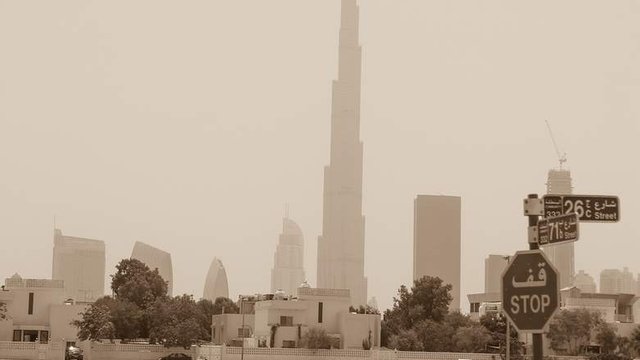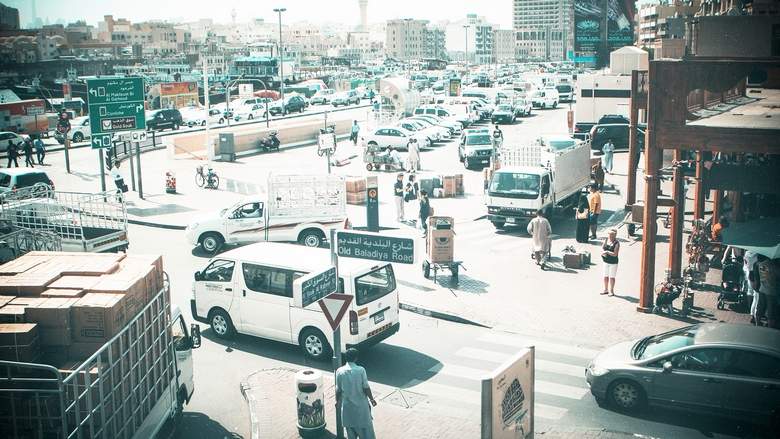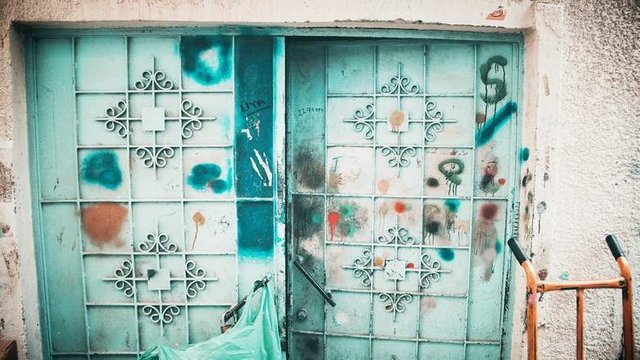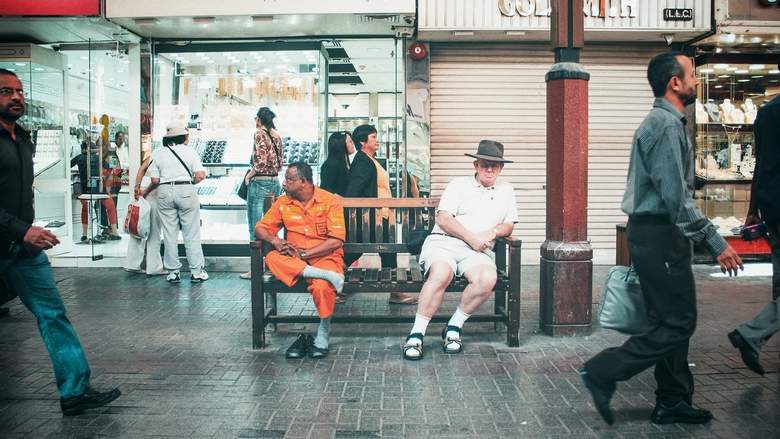Photographer Jalal Abuthina takes us on a tour through Dubai's most endearing neighborhoods

ROM THE PEEKING tower of the Burj Khalifa, to the iconic shape of the Burj Al Arab, the shimmering skyscrapers, the marble laid malls, the pristine beaches. To most of the world, this is Dubai. For those of us who live here though, there's much more to this city than world records and glass sky scrappers.
Street photographer Jalal Abuthina always felt that the city he called home wasn't represented in her truest form. There was a facade that was missing, a reflection that wasn't completely genuine, a history that wasn't available to share. A visual, pulsating history that makes Dubai a real city in the sense that it doesn't simply exist as a playground for those seeking glitz and glamour.

"People talk about how Dubai is multicultural. There is nowhere in Dubai where it is as a concentrated and obvious as Deira," Jalal tells us when we meet him in Alserkal Avenue's A4 café, 'specifically the Al Nasser Square area. It's one of the only places where you will have all these different identities and cultures, Nigerian, Moroccan, Kazak, Uzbek, American, all walking around completely in their own hometown cultural attire. But it's completely normal and no one is checking each other out like some kind of bizarre freak show. They are all occupying the same place with its own pulse, its own vibration... it has its own story."
Jalal has released three books of his street photography that capture these unique aspects of Dubai. Available at Kinokuniya in The Dubai Mall, Dubai: Behind the Scenes, gives you a glimpse of the streets and the people who walk them in areas rich in diversity such as Deira, Bur Dubai and Karama. Memories of Satwa takes us on a visual journey through the back alleys, shops and frequent residents of this unique section of Dubai, while The Best of Dubai Shop Names gives us a look into the visual language where cross-cultural translation makes for comical and endearing results.
With his nomadic approach, allowing the roads to guide him in the mazes of these often forgotten neighborhoods, Jalal spoke with City Times about the importance of a visual narrative and why he thinks it's important to make a record of Dubai behind the scenes.
How long have you been a photographer?
I started around 2001 in my last year of University where I was studying International Business. After I graduated I came here (Dubai) and I started working in real estate in 2003. That was my day job but I was doing photo projects throughout the whole time. I've always done street photography because I was documenting Montréal in my last year; I was always photographing public places, streets . . . the location changed but that was always the base.
Why are you interested in street photography as opposed to studio photography?
Because it's natural. The studio is more of a controlled environment. It's completely different from street photography, which is basically everything in its natural element and chaos unfolding. It appeals to me more. Also, I prefer natural light over flash or artificial lights.

What gave you the idea to photograph the areas of Dubai that the mainstream wouldn't necessarily be interested in?
In terms of communicating what's going on in the city, there is very little available on the shelves for tourists who actually visited here, who know nothing about the city. There isn't much in terms of educating tourists about every day life, everyday realities. So, it's looking at these areas which specifically never make the highlight which tourists don't really know anything about, which tour guides really don't know a lot about. There is no understanding, no comprehension on how society is actually constructed, how it functions, the layers behind it all. That's the idea behind the whole project. To give an understanding and provide insight to people who don't have access.
Why do you think it's important for people to be exposed to these areas of Dubai?
Because it broadens horizons and broadens understanding. If you go to a city and all you see are books about the buildings of the city you'll think there is nothing else going on in the city other than the buildings. So your interpretation of that place and that destination is going to be one dimensional, because you don't have access to any other kind of information. Not everyone is interested in that type of thing. There is no balance. There needs to be more natural, non-commercial forms of representations.
What do you think these areas add to the city?
A more humane element. The irony of it is that the city developed from these areas. These are the historical areas, they are like the nucleus of the city. Everything started out on the creek and then Bur Dubai and then Karama, so everything stemmed from these parts. They are the most under disturbed parts but the most vibrant at the same time, in terms of being a common meeting point for people, in terms of being natural.
When you first started photographing in Dubai, was it your plan to make a book or were you shooting organically and then decided to make books?
It was a combination of both. I started out photographing out of a love for it, just as a hobby. Then it reached a point where I had all these images and I was working full time as a photographer but I needed some kind of artistic outlet that wasn't commercial. So I decided now would be a good time to make a book about the city. I already had the materials, I just needed a little bit more. Which is what I dedicated another year to, basically conceptualise the whole thing and fill in a couple of blanks in terms of what images I needed to go with the catalogue that I already had.
What attracts you to take a scene or object and makes you think 'I want to capture that on film'?
It's a combination of things. Sometimes it's sights or elements which are unique only to that place. Certain building facades, certain areas where the crowd or the mix of the crowd is unique only to that area. For example, it's these nuances, these defining elements, that make a place a place but which I don't see communicated. People know of these places, they talk about them but there is no tangible record of it. That's kind of where it came from.
When you see someone you want to photograph how do you approach them? Are people receptive?
In some places people don't know that they are having their photo taken. But usually those are side profiles and back profiles so it doesn't matter. If it's a straight up picture of someone I would usually approach them or I will take their picture first and then approach them. If I want to catch them off guard and to make things more candid and natural I will photograph them and then I will approach them and I will explain to them why I took their picture. More often than not people actually want to cooperate. They are happy that they are included in something. I mean you get some people who don't want to be involved at all, who don't want their picture (taken), but most don't mind.

Do you think you need an element of trust when you're photographing people?
I think yeah, if they feel comfortable. It doesn't always work out. But if they don't feel comfortable, then they wouldn't go along with it. A lot of people actually like the attention, they are willing to go with it and they are flattered that you are photographing them.
How have you found the reception for the books?
Fantastic. A lot of people have been very supportive. I had to get approval from the Dubai Media Office to have these books on sale in the city and they were every supportive which is great. That's probably what means the most because if they approve it, if they give you a green light, they are giving you a thumbs up. If you get a thumbs up from the state that means they feel represented by these books as well.
You've worked in both film and digital but obviously these days it's very accessible to photograph things through our phones. Do you take pictures with your phone?
There are a lot of photographers who have turned completely to mobiles because it's a lot more practical and the technology is more advanced. It's actually a fantastic substitute to the normal camera. It's also less obvious - you can take photographs while using your earphones. But yeah, these days everyone is a photographer in a sense. Or not really a photographer, but everyone has the ability to photograph and to record.
Is it a good thing or bad thing?
It's just a thing. We are becoming a more visual culture, a digital visual animal but there's a lot of junk, a lot of nonsense. And there are a lot of people who aren?t really photographers, who aren't really creative and just have access to this platform and are recording their everyday experiences.

What's your favourite hidden gem in Dubai?
Probably just walking around Deira. You get lost there. I've been there quite a bit over the last few years and I still get lost. It's its own maze.
Congratulations @welcomedubai! You have completed some achievement on Steemit and have been rewarded with new badge(s) :
Click on any badge to view your own Board of Honor on SteemitBoard.
For more information about SteemitBoard, click here
If you no longer want to receive notifications, reply to this comment with the word
STOPCongratulations @welcomedubai! You have completed some achievement on Steemit and have been rewarded with new badge(s) :
Click on any badge to view your own Board of Honor on SteemitBoard.
For more information about SteemitBoard, click here
If you no longer want to receive notifications, reply to this comment with the word
STOPCongratulations @welcomedubai! You have completed some achievement on Steemit and have been rewarded with new badge(s) :
Click on any badge to view your own Board of Honor on SteemitBoard.
For more information about SteemitBoard, click here
If you no longer want to receive notifications, reply to this comment with the word
STOPCongratulations @welcomedubai! You have completed some achievement on Steemit and have been rewarded with new badge(s) :
Click on any badge to view your own Board of Honor on SteemitBoard.
For more information about SteemitBoard, click here
If you no longer want to receive notifications, reply to this comment with the word
STOP